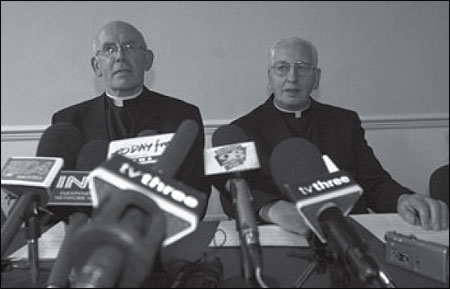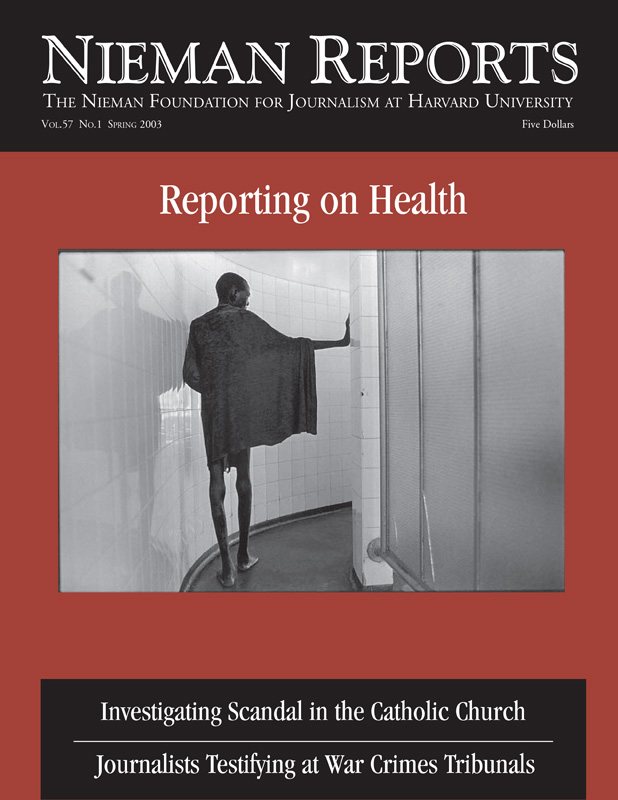
Archbishop of Armagh Sean Brady, left, and Cardinal Desmond Connell at a press conference in Maynooth College, where they announced an independent audit to be held into the controversy surrounding clerical child sexual abuse. Photo by © Leon Farrell/Photocall Ireland, August 2002.
Some years ago, a reporter for the Irish national broadcasting channel, RTÉ, asked the then-Archbishop of Dublin, Desmond Connell, if the archdiocese had paid money to a named victim of clerical sex abuse. The archbishop denied the charge. Later it emerged that the archdiocese had advanced a “loan” to an abusing priest effectively to pay off one of his victims.
Strictly speaking, the Cardinal was telling the truth: the archdiocese had not paid the money directly to the victim. The Cardinal’s deeply disingenuous reply would become a watershed for what would transpire in the years ahead—as the painstaking revelations of widespread clerical sexual abuse of children throughout Ireland emerged in the press, as did the attempts to cover up the scandal by some of the most senior members of the Catholic Church in Ireland.
A phenomenon of Irish journalism, and Irish life, is that our scandals are often first made public by reporters in another country, usually Britain. British TV stations beam into Ireland and are watched as easily and almost as regularly as the national channels. In the past 10 to 15 years, two of the biggest stories of corruption were broken by British TV stations. One concerned corrupt practices in the Irish beef industry; the other—clerical sex abuse—was brought to public attention in a series of documentaries.
The Irish media were no less avid than their British counterparts to get these stories out, but two things conspired against them doing so. The primary one was our libel laws. Irish courts demand high standards of proof when it comes to media allegations. Victims’ stories, no matter how compelling, were not enough to beat the libel laws. Concepts of freedom of speech and fair comment are not as highly developed in this country as they are in the United States. The second was a sort of cultural censorship, an unwillingness by the news media in general to give the bad news until the populace has been adequately softened up in advance. Sexual deviancy within the priesthood had been whispered about for decades; yet during those years no reporter was prepared to go behind the whispers.
Irish Press Tell the Story
The Irish press began to more aggressively pursue this story around the mid-1990’s. At that time, the church was already reeling from a series of scandals that in hindsight seem almost innocent: One concerned the fathering of a child by high-profile and popular Bishop Eamon Casey, the other concerned the fathering of another child by a high-profile Dublin priest. The fact that the media reported both stories proved that a massive sea change had taken place.
In 1994, for reasons too complicated to retell, the Irish government fell—in a very tangential way—over a scandal involving an abusing priest. The revelations that led to the controversy were revealed in a British TV documentary, which opened the floodgates in Ireland. One by one, victims emerged to tell their stories. Investigations were carried out, charges pressed, convictions secured. Once a conviction had been secured, the press at last were able to reveal what had happened and to dig deeper.
The reporting wasn’t easy. The Catholic Church stonewalled, denied and hid behind canon law—the laws of the church that appear to bypass the norms of civil law but which in fact have no legal standing. But the media were emboldened by the fact that respect for the church—in the wake of a series of scandals—was collapsing. Culturally, it became much easier for journalists to break the bad news.
Yet the Irish media were still hindered by a secrecy culture. There was precious little access to court or other documents. Unlike The Boston Globe reporters, who were able to access a mountain of church documents and records, the Irish media had to rely on the testimony of victims, most of which, naturally, was uncorroborated.
In the late 1990’s, RTE producer Mary Raftery produced a documentary called “States of Fear.” This wasn’t about abusing priests per se but rather about a whole culture of child abuse within the clerical-run institutions that looked after destitute, orphaned and abandoned children until relatively recent times. Raftery had managed to access records, and with that access she produced a program that sent shock waves through the church and state. The result: a strengthening and emboldening of the growing acceptance of widespread abuse among the clergy, accompanied by further revelations by victims of what they had suffered.
By 2000, the revelations and convictions were coming thick and fast. What was also becoming clear was that many of the abusing priests could have operated only if they were in some way sheltered by their leaders. In a direct parallel with the Boston experience, priests appeared to have been moved from parish to parish as soon as their abusing practices became known. In no case, however, were the abusers reported to the civil authorities.

George Bell, right, breaks down crying after trying to tell his story about childhood abuse during a protest in Dublin when Cardinal Desmond Connell was celebrating a mass. Photo by © Leon Farrell/Photocall Ireland, August 2002.
Confronting Church Denials
Archbishop Connell was now Cardinal Connell, and he was under pressure. He repeatedly denied any collusion on the part of the church hierarchy with the protection of abusing priests. Irish reporters found it difficult to break through the wall of obfuscation and denial. Then another British TV documentary propelled the story forward. Broadcast last year, it told the story of Father Sean Fortune, a priest who had committed suicide some time earlier, before he could be tried on 66 charges of rape and molestation of young boys. The program proved beyond doubt that Fortune had been protected, moved from parish to parish as soon as his “guilt” became known.
Bishop Brendan Comiskey, in charge of Fortune’s former diocese, resigned in the wake of the program revelations. A few months later RTE’s Raftery produced a program that for the first time pieced together the entire jigsaw of clerical abuse and the hierarchy’s collaborative efforts to keep knowledge of that abuse away from the people, particularly from the courts. Her program profiled a number of convicted or known clerical abusers and traced their abusive path from parish to parish. Viewers were left in no doubt that the men had been deliberately moved on to avoid detection by the civil authorities.
Raftery’s program proved to be another watershed. There were calls from victims’ groups, from some Catholic laity, even from some priests for Connell to resign. The Minister for Justice promised to set up a public inquiry into the alleged collusion and cover-up, an inquiry with powers to compel witnesses to attend. Connell already had another church-run inquiry under way that he was forced to drop.
It’s been a long road for the Irish media. The Catholic religion is in the nation’s DNA, and it is consequently much more difficult to explore and attack the Catholic Church than in other, more secular countries. Yet, despite these difficulties, individual journalists and producers have produced fantastic investigative work. But it was the added input of our colleagues across the sea that made the vital difference.
Emily O’Reilly, a 1988 Nieman Fellow, is political correspondent with The Sunday Times in Ireland. She has written and broadcast on the topic of clerical sex abuse, with special emphasis on the reaction of the political system to the scandal.



